
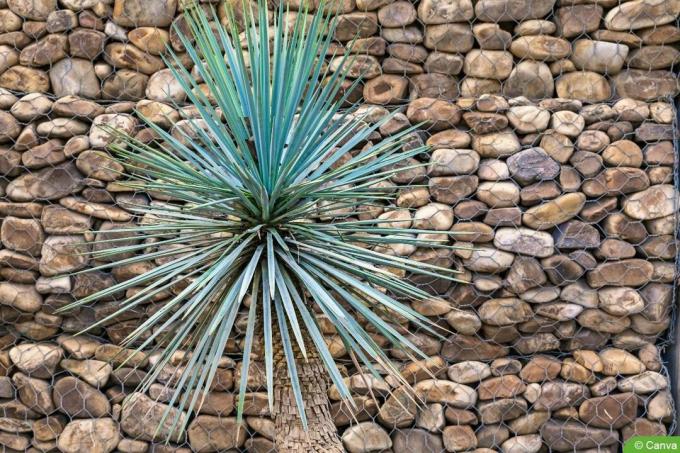
Table of contents
- Characteristics
- Location
- soil / substrate
- plants in the open air
- heyday
- Pour
- Fertilize
- Cut
- repot
- hibernate
- Planted Yucca rostrata
- In the bucket culture on the balcony
- Overwinter indoors
- multiply
- diseases and pests
The blue yucca is a popular ornamental plant because it is easy to care for, produces beautiful blue-green leaves and develops a flower spike up to two meters high in spring.
Characteristics
- botanical name: Yucca rostrata
- Common names: Blue Yucca, Big Bend Yucca
- Plant genus: Yucca (Palm Lilies)
- Growth: upright, stem-forming (100 to 400 centimeters)
- maximum growth height (without inflorescence): 500 centimeters
- maximum growth width (crown diameter per trunk): 150 centimeters
- Leaves: Evergreen, rough, narrow, acuminate, 25 to 60 long, blue to blue-green, finely toothed leaf margin
Location
Blue yucca can
- planted in the garden
- as balcony or terrace plants as well
- as pure indoor plants (ideally with overhead glazing)
being held.
As a semi-desert plant, it needs a bright and full sun, and preferably a hot and dry location, regardless of how it is kept. Planted out as well as on the balcony and terrace, the blue palm lily should be given a place that protects it from rain and a little from the wind.
Tip:
Outdoors, Yucca rostrata likes it under a roof or under a roof. Canopy, on the house wall or a stone surface is best.
soil / substrate
Blue yuccas are not only sensitive to rain, but also to wet soil. Therefore, permeability is the decisive criterion for soil or soil. substrate. Outdoors, the plant feels comfortable in a sandy and stone-interspersed soil. In addition, the soil should have a high mineral content. The clay and humus content may be low.
In the bucket culture, a mixture of:
- 50 percent cactus soil or special palm soil
- 50 percent loosening material such as sand, gravel, split or lava granulate
A notice:
If Yucca rostrata comes into normal garden soil outdoors, you should mix it with loosening materials, as in pot culture.
plants in the open air
For planted blue yuccas, it is important that the soil is well drained to prevent excessive waterlogging. If the site is at risk of overwatering, you should add an 8 to 12 inch layer of coarse rubble or gravel to the bottom of the planting hole for drainage. Proceed as follows:
- Carefully pull the big bend yucca out of the pot with the soil
- Lay the plant horizontally
- Support the root area with your hands when pulling it out
- do not remove old substrate (protection of tender roots)
- Dig a planting hole
- Size: slightly wider and deeper than the root ball
- possibly. Create a drainage layer and cover with a water-permeable plant fleece
- Place the yucca rostrata in the middle
- The top edge should correspond to that in the pot
- fill up (if necessary) Mix loosening material under the soil beforehand)
Tip:
Support the plant with a sturdy stick to stabilize it to prevent it from tipping over. Yucca rostrata is best used as a solitaire.
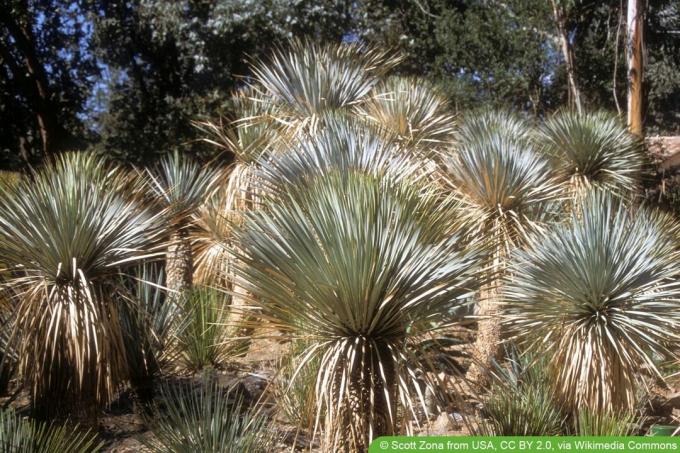
heyday
The flowers of the Big Bend Yucca that grow above the leaves are impressive:
- Inflorescence: 100 to 200 centimeters
- Single flower: three to six centimeters long and up to 3.5 centimeters wide
- Shape and color: bell-shaped, hanging, white to cream-colored
- Flowering time: March to April
During the flowering period, the tuft of leaves can look a little plucked, as the plant does not develop new leaves during this time. They only grow back when the inflorescence has died. If this development begins, you can cut off the flower with a pair of sharp pruning shears.
Pour
When it comes to watering, the motto for Yucca rostrata is: less is more. In the tub culture, it is usually sufficient if you water the plant every two weeks from mid-March to the end of October. So that the potted plant does not suffer from waterlogging, you should immediately remove excess watering water from the saucer.
In the case of planted specimens, young palm lilies and new plantings depend on additional watering in the event of prolonged drought, since their root system is still small.
Fertilize
Fertilizers are also extremely modest for the blue palm lily. For a good supply of nutrients, it is sufficient if you fertilize the ornamental plant in the pot once a month between April and August with a special yucca fertilizer.
In the field, the plants get by without additional nutrients. However, it does not harm them if they are occasionally given a yucca fertilizer during the growing season.
Cut
The blue palm lily does not need a regular cut. However, the lower leaves of the tuft lose their color with age and die off as the trunk slowly pushes up from the bottom. You can cut off these leaves close to the stem. Under no circumstances should you pull out dead leaves, because the leaf bases have a protective function for the trunk.
A notice:
Leave the dead leaves on the plant, over time form a long dress below the crown.
repot
With a growth rate of between two and ten centimeters per year, the blue palm lily is one of the slow-growing plants. It therefore only needs a new pot every few years. This can be a bit larger. It is important that the bottom has drainage holes for excess irrigation water.
A notice:
Repot the root ball with the old soil. This way you can avoid damage to the tender roots.
hibernate
There are different options for hibernation, depending on where the palm lily is located:
Planted Yucca rostrata
Since the blue palm lily tolerates temperatures down to minus 20 degrees Celsius, it is considered hardy. Nevertheless, you should protect the plant from cold and frost from minus 17 degrees Celsius. If the thermometer threatens to fall below minus 20 degrees Celsius, Yucca rostrata needs protection against the cold.
A notice:
If the temperature returns within the tolerance range, you should open or remove the thermal protection. If the plant stays well packed, it could understand the heat as the end of the cold season and start to sprout.
However, the biggest enemy of the ornamental plant is moisture in the form of rain or snow. Therefore, the crown in particular needs moisture protection in winter to avoid permanent moisture. If the plant is not protected by a roof, you can protect the tuft from moisture with a translucent awning, party tent or umbrella. The root area may get wet if it is ensured that the water can drain off easily.
In the bucket culture on the balcony
A potted Big Bend Yucca is only hardy outdoors if you protect the plant. For the root area, it is advisable to cover the tub with a plant protection fleece and place the plant on a wooden board or a styrofoam plate (to protect against the cold from below).
To protect the crown from permanent wetness, the yucca gets a place under a sufficiently large roof. Alternatively, you can place the blue palm lily under an awning or a roller shutter. For smaller specimens, you can attach a translucent umbrella to the trunk.
Overwinter indoors
If your Yucca rostrata is to overwinter indoors, it absolutely needs a bright location. With a cool hibernation, the temperature in the winter quarters should be around + 10 degrees Celsius. Since the plant is going into hibernation, it is not fertilized until March and the water supply is reduced. In the spring, slowly get the blue palm lily used to normal care again. During a warm hibernation, the ornamental plant needs a little more water, and in this case it is not fertilized either.
multiply
In principle, cuttings and seeds are suitable for propagating Yucca rostrata. However, both types of propagation are hardly or not at all possible. The plants do not form seeds because their pollinators, the so-called Yucca moth, does not fly in this country. You can only take cuttings when the stem is branching, which only happens in older specimens, if at all.
diseases and pests
The blue palm lily is spared from pests in this country because of its rough leaves. However, if kept too wet, fungal infections can develop in the roots and/or crown. Since the treatment is difficult, in this case you should contact a professional.
 garden editorial
garden editorial I write about everything that interests me in my garden.
Learn more about palm trees
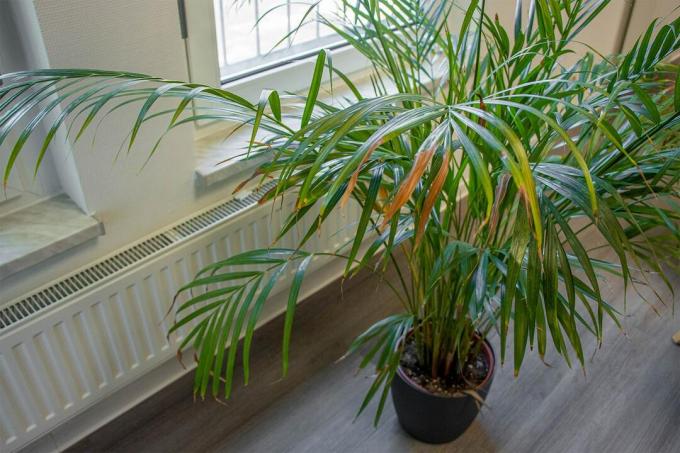
Palm leaves hanging: save yucca & co
Palm trees give the home a southern flair. However, if Yucca & Co. let their leaves droop, their sight is rather desolate. The causes of hanging palm fronds vary. A rescue attempt is always worthwhile.
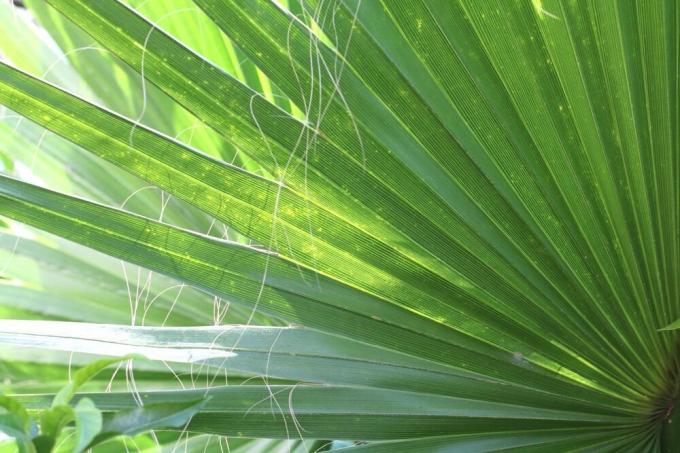
Washington Palm: Care From A-Z | Overwinter Washingtonia robusta
The Washington palm is a decorative plant that can grow to an impressive size. Due to the lack of winter hardiness, the plant is usually kept indoors in this country. When it comes to care, the palm makes certain demands so that healthy development can occur.

Areca palm, Dypsis lutescens: basics of care
The Areca Palm is a beautiful plant for indoor greenery. When it comes to care and location, the palm has certain requirements, if these are met, the plant will thrive. In order for the plant to grow constantly green, it needs the right lighting conditions.
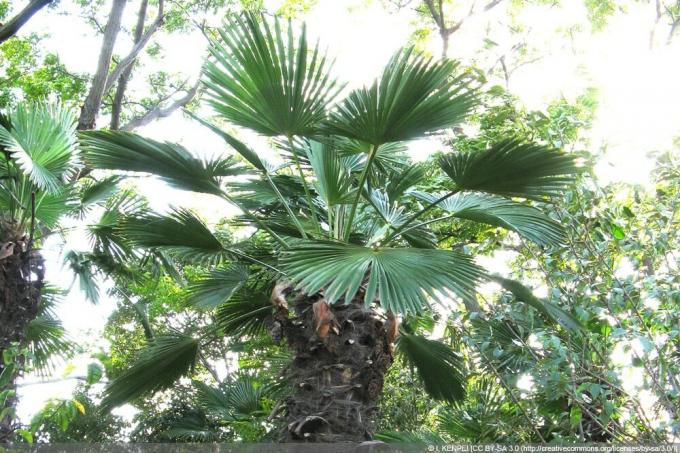
Wagner's hemp palm, Trachycarpus wagnerianus: Care from A-Z
If you want exotic flair in your garden or on your terrace, you can't avoid Wagner's hemp palm. No wonder: the extremely decorative umbrella palm not only looks impressive, but is also very robust. More about this is here.

Candle palm lily, Yucca Gloriosa – Care from A-Z | Is she hardy?
A yucca is better known to most as an exotic houseplant, the candle palm lily (bot. Yucca gloriosa) is also ideal as an outdoor plant, bringing a touch of tropical flair to your garden.

Golden fruit palm: is Chrysalidocarpus lutescens poisonous to cats?
The golden fruit palm is a popular houseplant that scores with its attractive appearance. However, many pet owners are unsure whether the plant could be toxic to cats. There is also a risk of confusion with other palm species that definitely have toxic properties.
